Critical control points for lamb survival
This article talks about when newborn mortality occurs and how to prevent it.

Introduction
“What is a reasonable mortality rate for lambs?” This is a question frequently asked by many producers. However, the answer is not straightforward, as it depends on many factors including lambing rate, management practices and production system. Producers commonly ask this question to determine if they have a problem, but looking at overall lamb mortality without considering the farm’s production figures and its specific patterns of loss is not very useful. A better approach would be to begin by identifying the pattern of loss and their magnitude. These patterns may show some variation from year to year, but it is common that farm-specific patterns emerge. Some losses can be greatly reduced with prevention strategies while others are harder to address. Once patterns are identified, it is possible to target those that have the greatest potential to effect. In this article I will discuss to how assess loss patterns and how to implement strategies to mitigate loss with the overall goal of improving production efficiency while maintaining a high standard of animal welfare.
Assessing patterns of loss
The vast majority of lamb loss occurs during the first week of life and more specifically during the first 24 hours under “typical” conditions, so we will focus on these time frames. Our goal is to document major patterns of loss efficiently, so what follows is a basic producer’s guide to loss assessment. A sharp knife or scalpel, estimated age at death, and knowledge of basic anatomical features are all that are needed to differentiate between the major causes of death: 1) stillborn, 2) starvation/exposure, 3) abortion diseases, and 4) respiratory diseases (pneumonia). Age at death is an important criteria to differentiate among them, so let us break down loss accordingly.
- Pre-term loss. Lambs born before 140 days of pregnancy do not have sufficient lung surfactant to survive, so pre-term lambs are typically born dead or live only a few minutes following birth. These lambs will have sparse wool coats, primordial features, and relatively small size. A general rule of thumb is that pre-term loss <2% is “normal”, whereas greater loss warrants investigation for abortion disease. In cases of abortion disease outbreak it may also be expected, depending on the abortion disease, to also find a higher percentage of both full term lambs born dead and weak lambs that succumb to starvation/exposure early in life (day 1-3).
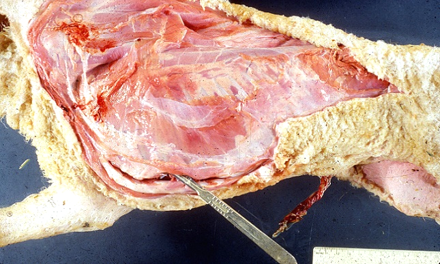
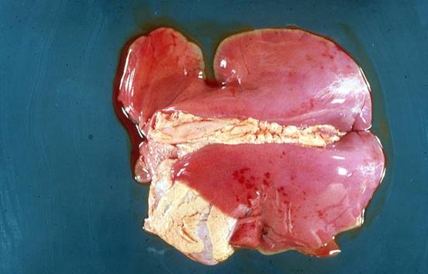
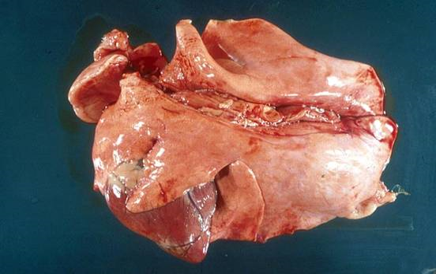
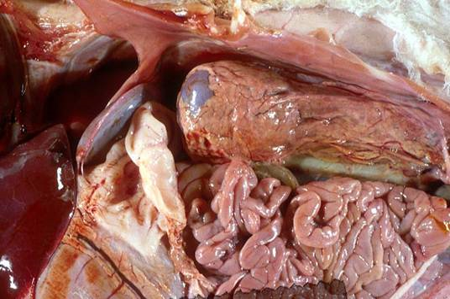
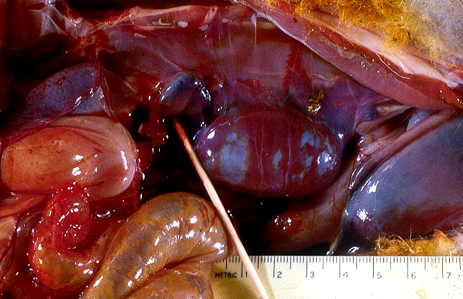
- Loss during the first 24 hours. It is important to differentiate between lambs that did not take a breath (stillborn lambs) and those that died from other causes during day 1. Stillborn lambs will have non-inflated lungs, copious brown fat reserves, and the soft tissue covering the hooves will be undisturbed. A simple incision to expose the rib cage, then two more to open the thoracic and abdominal cavities (Figure 1) will reveal whether or not the lungs were inflated (Figure 2) and the brown fat reserves depleted (Figure 3) at death. Brown fat surrounds the kidneys at birth, and depleted reserves have a dark red color. Starvation/exposure lambs have inflated lungs but may vary in the rate of brown fat depletion depending on their rate of heat loss. During cold climatic conditions, lambs can easily deplete their reserves within 12 hours, whereas during mild conditions it may take several days. Lambs born under extreme conditions may actually lose body heat so fast that they die before brown fat reserves are spent (simple hypothermia). More typical is a finding of inflated lungs and depleted brown fat reserves. If possible, try to distinguish between these conditions because prevention strategies differ.

- Loss day 2-7. Lambs that die of starvation/exposure >36 hours under cold conditions (less than 0°C) typically have suckled but were not able to consume enough colostrum/milk to maintain heat production. Pneumonia losses are more frequent during the first week of life than later and are most typically characterized by lesions (often red discoloration) in the region of the lung surrounding the heart (anterior/ventral) (see Figure 4). Pneumonia progresses quickly in young lambs, so death may be the first symptom. Other important but typically less frequent causes of death are enterotoxemia and scours. Enterotoxemia during week 1 is characterized by sudden death, a milk-filled stomach, and hemorrhage of the small intestine. Scours caused by E. coli are characterized by watery diarrhea, excessive salivation and a cold mouth.
Pattern/magnitude of loss: Opportunities for impact
It is important to understand that some patterns of loss are relatively easy to address while others are more difficult to impact. What follows is a general guideline of “typical” ranges of loss (according to lambing percentage) of lambs that make it to term. Abortion diseases have been omitted from this table because the majority of those losses are pre-term. As mentioned previously, pre-term losses of greater than 2% are a trigger point to initiate investigation into possible abortion disease(s). Disclaimer: These mortality ranges are based on my field experience as well as review of many field studies of lamb loss during week 1 in both shed and pasture lambing situations. They are, however, estimates and must be viewed accordingly.
| Lambing percentage | ||||
| Low | Moderate | High | ||
| Loss category | mean=130% | mean=165% | mean=200% | Impact potential |
| Stillborn (full-term) | 1-8 | 2-12 | 4-18 | Low |
| Starvation/Exposure | 1-10 | 2-15 | 3-20 | Medium |
| Respiratory Disease | 0-10 | 0-15 | 0-20 | High |
Table 1. Estimated relationship between lambing percentage and pattern of lamb loss during the first week of life. Lamb loss is expressed as a range of loss ([dead lambs/ total births of both live and dead lambs] x 100) that may occur under diverse farm scenarios. Lambing percentage = total lambs full-term born dead or alive/number of ewes with full-term pregnancies*100. Impact potential: Low=0-30%, Medium=30-60%, High=60-100% reduction in mortality loss.
An example of loss that is difficult to impact would be non-disease related stillborn loss in highly prolific lines of sheep. While the idea of “acceptable” levels of lamb mortality may seem like resignation, it is important to understand that a flock with a 225% lambing rate may find it difficult to reduce overall loss below 15% even with excellent preventative measures and optimal birth time management. Part of this problem in prolific sheep (lambing rates over 200%) is due to the fact that they experience a higher rate of stillborn loss (5-8% of lambs dropped) due to “placental insufficiency” and dystocia. These types of loss are hard to impact (except perhaps through genetics, although this has not been well documented). The good news, however, is that it is possible to impact other patterns of loss in these flocks (starvation/exposure, pneumonia and abortion losses) with prevention strategies. The following is a list of prevention strategies that individually and collectively can make a significant impact on reducing loss during the first week of life.
Prevention strategies to target loss
- Birth zone climate.
- Change birth time. In pasture lambing programs it is ideal to time lambing until after the soil temperature is above 50 ̊F (10 ̊C) to reduce loss due to cold temperature/wind/rain. This also conveniently times birth to commence after grass growth is well started, insuring that ewes receive quality forage during late pregnancy to optimize fetal growth and colostrum production. However, waiting until soil temperature is appreciably warmer to start the birth period is not optimal, as this creates a new set of problems due to warmth and humidity (increased incidence of “flystrike” and gastrointestinal parasite infection). Indoor lambing programs are also susceptible to losses due to starvation/exposure, and moving birth from January to March may similarly reduce loss.
- Modify environment. In indoor lambing programs, maintaining ambient temperature above 32 ̊F (0 ̊C) will reduce starvation/exposure losses appreciably. But can this be done economically, safely and without detrimental increases in humidity? Supplemental heat in the drop and early weaning areas can provide a “dry” heat but will require substantial energy to heat large barn areas. The cost:benefit of this practice would obviously need to be considered. Another approach is to design a facility with an insulated drop/early rearing area that relies on animal heat to maintain ambient temp above 0 ̊C while allowing for sufficient air exchange to prevent harmful levels of humidity (see Figure 5).
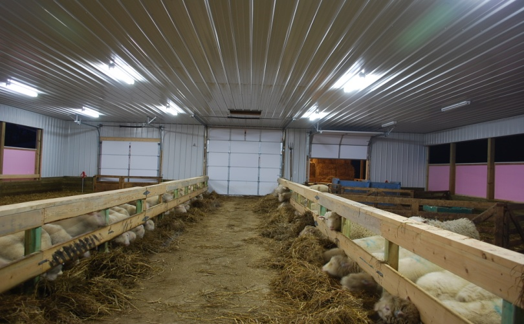
Preliminary analyses of two such facilities indicate a 5-7 year payback period when accounting for the cost of insulation materials compared to lambs saved. There are also improvements in flock welfare that are harder to economically define but important to consider as part of comprehensive management program. Another less tangible, albeit important benefit, is improved shepherd comfort too.
Recently we designed a barn at Michigan State University specialized for lambing with a combination of insulated attic and walls, side wall curtain that can open at nearly any part of the side wall and tunnel ventilation using fresh air than can be heated before entering the air distribution tunnels. The heating of air is controlled thermostatically in the barn and set to keep barn temperature a few degrees above freezing. This system brings in fresh, warm air and maintains high air quality and optimal temperature for winter lambing.
- Improve ventilation. Adequate air exchange is vital to reducing humidity levels that can lead to increased incidence of pneumonia, scours and other issues (coccidiosis,etc.). This need, however, has to be balanced against excessive drafts that will promote hypothermia in newborn lambs. Ridge vents and adjustable sidewall air intake control (curtains, louvers) are means of providing ventilation without producing excessive draft in passive ventilation systems.
- Nutrition. Optimizing nutritional management of the pregnant ewe is of primary consideration in improving lamb survival during the first week of life. This topic is too broad to cover in detail here, but meeting both energy and protein as well as micronutrient (vitamins and minerals) requirements for pregnancy are of central importance in determining size at birth and colostrum production. These are two key factors influencing survival during week 1. Therefore, providing the appropriate levels of ewe nutrition should be a priority in preventing lamb loss later.
- Birth time management (dynamics of jug and mixing pen management, length/concentration of birth period). Mismothering is one of the underlying causes of starvation/exposure, so consideration must be given to optimizing the time in claiming pens and the dynamics (residence time, group size, animal density) of mixing pens. If starvation/exposure is elevated during days 2-7, then this is an important area of focus. One strategy that can be beneficial for birth time management is to concentrate the birth period using the ram effect during the prebreeding period. Introducing rams to ewes that have been relatively isolated from rams has the effect of synchronizing estrus. This is efficiently accomplished by exposing ewes to vasectomized rams for 14 days and then replacing these rams with intact males. This will concentrate estrus such that the majority of ewes will exhibit heat in two clusters, roughly 17-18 and 22-23 days after initial ram introduction (introduction of the vasectomized ram). A concentrated drop period has advantages for birth time management as long as labor is not a limiting factor. Concentrated birth periods greatly increase cross fostering opportunities, thus decreasing starvation/exposure and decreasing rearing costs (i.e. less milk replacer, more lambs nursed per ewe). Concentrated birth periods also decrease the build-up of pathogens in the barn, thus reducing incidence of scours and possibly pneumonia.
- Health program. Elimination of chronic disease (i.e. maedi-visna or ovine progressive pneumonia [OPP]) will reduce the incidence of starvation/exposure due to inadequate colostrum/milk production. Flocks that have eliminated maedi-visna/OPP report huge decreases in the number of lambs reared artificially, as older ewes have sufficient colostrum/milk to support their lambs. When abortion is a documented problem, vaccination programs may be an essential step in reducing losses. Finally, booster vaccination of ewes during late pregnancy against enterotoxemia types C and D and well as tetanus is likely a cost effective measure of reducing lamb mortality. Lambs receive effective protective antibody titer via passive immunity through colostrum consumption when moms are vaccinated and are protected until 40-50 days old. Vaccination of lambs in early postnatal life (<2 weeks of age), however, is not effective in protection against the major toxins produced by clostridium perfringens type D and therefore is not advised.
- Genetics - “Hybrid vigor” or heterosis is achieved by maximizing the use of cross breeding. This strategy can reduce mortality by close to 20%. There are also differences between breeds in survival traits including suckling drive and aspects of maternal behavior. In general, breeds selected for specific production traits (wool, carcass quality) are inferior to those more subject to natural selection (less shepherding and specific production characteristics not selected). A challenge exists in identifying sheep that are superior in both production and survival, as these traits tend to be opposed. Evaluation of the genetics of cold stress resistance in newborn lambs has demonstrated that cold resistance has modest heritability (h2=0.40) manifest mainly through determinants of heat production and to a lesser degree through birth coat characteristics. More recently, specific polymorphisms for regulatory genes involved in newborn thermogenesis have been associated with incidence of newborn mortality. These findings suggest potential for use of these polymorphisms as markers for selection of cold resistance in newborn lambs.
Treatment interventions to reduce loss
The impact of treatment interventions in reducing newborn lamb mortality are difficult to quantify. Certain interventions are simply a part of responsible shepherding: ensuring a high standard of animal welfare (birth time assistance during clear cases of dystocia, efficient treatment of hypothermic lambs). There clearly are, however, situations when increased shepherding time has little impact on reducing mortality and likely a negative impact in terms of returns on the labor invested. Therefore these interventions need to be considered carefully in terms of efficiency and impact.
Summary
Developing prevention programs to reduce lamb mortality starts with assessing mortality patterns on an individual farm basis. Identifying if the lamb died in or out of utero and whether or not it received milk are critical to defining existing problems and potential solutions. Prevention programs should be prioritized to target loss in areas with the greatest impact potential. Examples of high impact areas include optimizing maternal nutrition programs, improving the birth environment (heat and humidity), using cross breeding programs, and implementing disease prevention programs such as vaccinations.
Selected References
Arsenault J, Dubreuil P, Girard C, Simard C and Belanger D. 2003. Maedi-visna impact on productivity in Quebec sheep flocks. Preventive Veterinary Medicine 59:125-137.
de la Rosa C, Hogue DE, and Thonney ML. 1997. Vaccination schedules to raise antibody concentrations against e-toxin of Clostridium perfringens in ewes and their triplet lambs. Journal of Animal Science 75:2328-2334.
Dalton DC, Knight TW and Johnson DL. 1980. Lamb survival in sheep breeds on New Zealand hill country. New Zealand Journal of Agricultural Research 23:167.
Dohoo IR, Heaney DP, Stevenson RG, Samagh BS and Rhodes CS. 1987. The effects of maedi-visna virus infection on productivity of ewes. Preventive Veterinary Medicine 4:471-484.
Eales FA, Small J and Gilmour JS. 1983. Neonatal mortality and its causes. In: W. Haresign (Ed.) Sheep Production. pp 289-298. Butterworths, London.
Forrest RH, Hickford JG and Frampton CM. 2007. Polymorphism at the ovine beta3-adrenergic receptor locus (ADRB3) and its association with lamb mortality. Journal of Animal Science 85:2801-6.
Gama LT, Dickerson GE, Young LD and Leymaster KA. 1991. Effects of breed, heterosis, age of dam, litter size and birth weight on lamb mortality. Journal of Animal Science 69:2727
Hight GK and Jury KE. 1970. Hill country sheep production. II. Lamb mortality and birth weights in Romney and Border Leicester*Romney flocks. New Zealand Journal of Agricultural Research 13: 735-752.
Hinch GN, Kelly RW, Owens JL and Crosby SF. 1983. Patterns of lamb survival in high fecundity Booroola flocks. Proceedings of the New Zealand Society of Animal Production 43:29.
McCutcheon SN, Holmes CW, McDonald MF. 1981. The starvation-exposure syndrome and neonatal lamb mortality: A review. Proceedings of the New Zealand Society of Animal Production 41:209.
Notter DR and Copenhaver JS. 1980. Performance of Finnish Landrace crossbred ewes under accelerated lambing. II. Lamb growth and survival. Journal of Animal Science 51:1043.
Rook JS, Scholman G, Wing-Proctor S and Shea M. 1990. Diagnosis and control of neonatal losses in sheep. Veterinary Clinics of North America: Food Animal Practice 6: 531-652.
Slee J. 1981. A review of the genetic aspects of survival and resistance to cold in newborn lambs. Livestock Production Science 8: 419-429.
Ungerfeld R, Forsberg M, and Rubianes E. 2004. Overview of the responses of anoestrous ewes to the ram effect. Reproduction, Fertility and Development 16:479-490.
Wolff JE, Baker RL, Dobbie PM, Ford AJ and Jordan RB. 1987. Genetic aspects of cold resistance in new-born lambs. Proceedings of the New Zealand Society of Animal Production 47: 93-98.
Woolliams CG, Wiener G and McLeod NS. 1983. The effect of breed, breeding system and other factors on lamb mortality. 2. Factors influencing the incidence of delayed birth, dystocia, congenital defects and miscellaneous causes of early death. Journal Agricultural Science 100:553.



 Print
Print Email
Email

